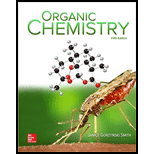
Concept explainers
(a)
Interpretation: The axial or equatorial substituents on the rings of the given structure A are to be labeled.
Concept introduction: The different spatial arrangements of atoms that results from the rotation about single bonds are called conformational isomers. The chair conformation of cyclohexane consists of six axial and six equatorial bonds.
The six axial bonds present one on each carbon atom, are parallel and alternate to each other and are in up-down position.
The six equatorial bonds present one on each carbon atom, are present in three sets of two parallel ring bonds. They are in alternate position between the sides around the ring.
(b)
Interpretation: The skeletal structure of A with the help of wedges and dashed wedges is to be drawn in order to show whether the substituents are located above or below the rings.
Concept introduction: The different spatial arrangements of atoms that results from the rotation about single bonds are called conformational isomers. When two substituents in a conformation are in up or down direction then it is known as cis conformation. But if one substituent is in upward direction and the other is facing down direction, then the conformation is known as trans.
Want to see the full answer?
Check out a sample textbook solution
Chapter 4 Solutions
ORGANIC CHEMISTRY-MOLYMOD PACKAGE
- Problem 4.3 Problem 4.4 Problem 4.5 Draw the five constitutional isomers having molecular formula C6H₁4. Review classifying carbons and hydrogens in Section 3.2, and draw the structure of an alkane with molecular formula C₂H₁6 that contains (a) one 4° carbon; (b) only 1° and 2° carbons; (c) 1°, 2°, and 3° hydrogens. (a) Which compounds (B-F) are identical to A? (b) Which compounds (B-F) represent an isomer of A? B C D E Farrow_forwardHydrocarbon A possesses a significant dipole, even though it iscomposed of only C—C and C—H bonds. Explain why the dipole arisesand use resonance structures to illustrate the direction of the dipole.Which ring is more electron rich?arrow_forward4. (a) Draw a skeletal (line-bond) structure for 3,4-dimethylhexane. (b) Draw a sawhorse representation of any staggered conformation of this molecule looking down the carbon-3 to carbon-4 bond. (c) Draw a Newman projection looking down the carbon-3 to carbon-4 bond of the same conformation that you drew as a sawhorse representation.arrow_forward
- HO₂ H COOH COOH V POH HOT COOH cooff VI Ho HO COOH COOH VI H H COOH COOH VIIL OH OH Question: In the structures / examples abovke Identify V, VI, VII and VIII as Identical enantiomers, ciastereomes, stereo/cumers and/or structural isomers (there are 6 pairs 7 Comp eand to discover te I&T I TEN TEM TIMIN).arrow_forwardThe cis ketone A is isomerized to a trans ketone B with aqueous NaOH. Asimilar isomerization does not occur with ketone C. (a) Draw thestructure of B using a chair cyclohexane. (b) Label the substituents in Cas cis or trans, and explain the difference in reactivity.arrow_forwardThe cis ketone A is isomerized to a trans ketone B with aqueous NaOH. A similar isomerization does not occur with ketone C. (a) Draw the structure of B using a chair cyclohexane. (b) Label the substituents in C as cis or trans, and explain the difference in reactivity.arrow_forward
- Hello, please draw and name the organic molecules according to the following criteria (draw the entire structure out clearly with each C and H and other atoms and name it) a) The molecule must have a benzene, could potentially have a rxn with H2 using a platinum catalyst and has at least one branch b) The molecule must have an alcohol R-chain, could produce a carboxylic if reacted with KMn04 and has contains two or more branchesarrow_forward(ii) Name all the compounds D, X, Y, Z and W according to the IUPAC nomenclature.arrow_forwardThe skeletal line formula for a branched alkene is shown below. (i) What is the molecular formula of this compound? (ii) How many carbon atoms are in the longest chain, ignoring the double bond? (iii) What is the longest chain incorporating both carbons of the double bond? (iv) How many substituents are on this chain? (v) Give the IUPAC name for this compound. [6]arrow_forward
- Give IUPAC Nomenclature for both compounds.arrow_forward(a) A phenyl group has the molecular formula CH- and is represented by the symbol Bn. True False (b) Para substituents occupy adjacent carbons on a benzene ring. (c) True False (e) 3-Bromobenzoic acid can be separated into cis and trans isomers. True O False (d) 1-Phenylcyclohexene is a planar molecule. True False Benzene, naphthalene, and phenanthrene are polynuclear aromatic hydrocarbons (PAHs). Truearrow_forwardPlease do parts a and Barrow_forward
 ChemistryChemistryISBN:9781305957404Author:Steven S. Zumdahl, Susan A. Zumdahl, Donald J. DeCostePublisher:Cengage Learning
ChemistryChemistryISBN:9781305957404Author:Steven S. Zumdahl, Susan A. Zumdahl, Donald J. DeCostePublisher:Cengage Learning ChemistryChemistryISBN:9781259911156Author:Raymond Chang Dr., Jason Overby ProfessorPublisher:McGraw-Hill Education
ChemistryChemistryISBN:9781259911156Author:Raymond Chang Dr., Jason Overby ProfessorPublisher:McGraw-Hill Education Principles of Instrumental AnalysisChemistryISBN:9781305577213Author:Douglas A. Skoog, F. James Holler, Stanley R. CrouchPublisher:Cengage Learning
Principles of Instrumental AnalysisChemistryISBN:9781305577213Author:Douglas A. Skoog, F. James Holler, Stanley R. CrouchPublisher:Cengage Learning Organic ChemistryChemistryISBN:9780078021558Author:Janice Gorzynski Smith Dr.Publisher:McGraw-Hill Education
Organic ChemistryChemistryISBN:9780078021558Author:Janice Gorzynski Smith Dr.Publisher:McGraw-Hill Education Chemistry: Principles and ReactionsChemistryISBN:9781305079373Author:William L. Masterton, Cecile N. HurleyPublisher:Cengage Learning
Chemistry: Principles and ReactionsChemistryISBN:9781305079373Author:William L. Masterton, Cecile N. HurleyPublisher:Cengage Learning Elementary Principles of Chemical Processes, Bind...ChemistryISBN:9781118431221Author:Richard M. Felder, Ronald W. Rousseau, Lisa G. BullardPublisher:WILEY
Elementary Principles of Chemical Processes, Bind...ChemistryISBN:9781118431221Author:Richard M. Felder, Ronald W. Rousseau, Lisa G. BullardPublisher:WILEY





